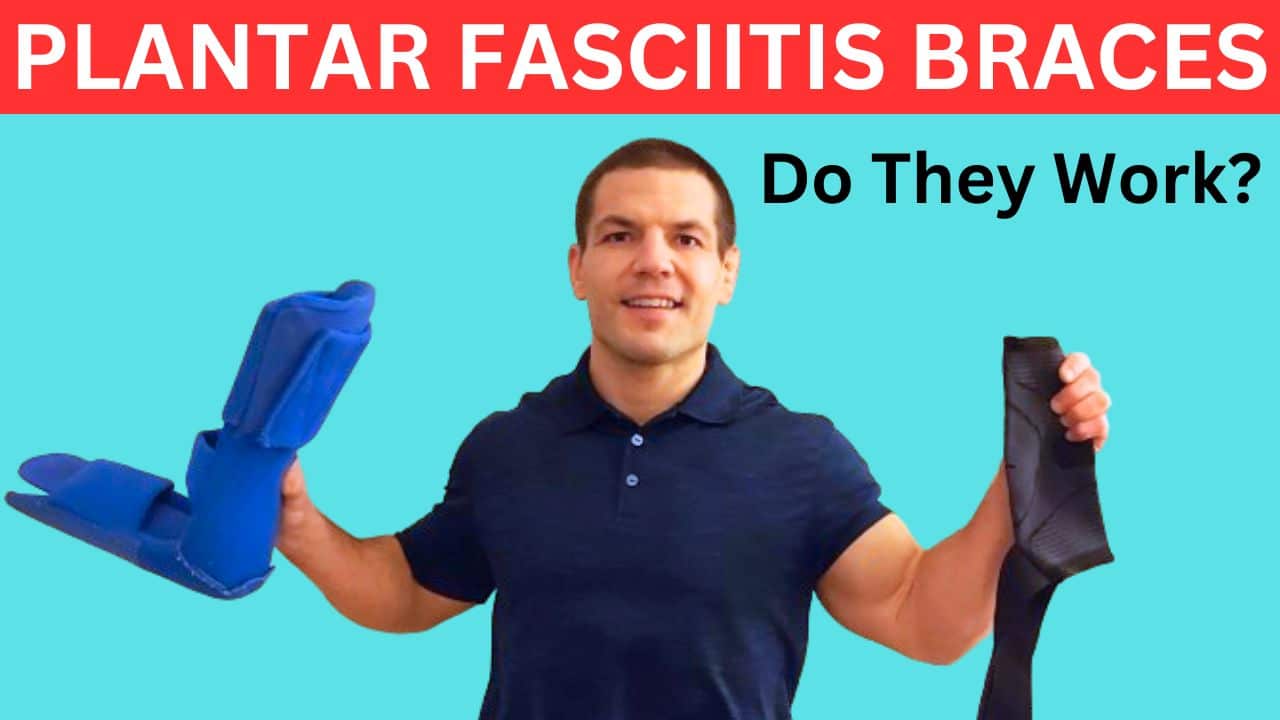Plantar Fasciitis Braces Work?
Plantar fasciitis braces can work depending on what type brace you use. Watch this video to learn about 3 common kinds of plantar fasciitis braces and the advantages and disadvantages of each of them.

3 Kinds of Plantar Fasciitis Braces
The three types of plantar fasciitis braces that are most common are:
Night Splint Braces For Plantar Fasciitis
A night splint is commonly worn at night when you're sleeping.
The goal of a night splint is to keep your foot at a 90-degree angle while you sleep in order to prevent your calves from getting stiff.
Some brands actually have something where they pull your toes backward like this.
The goal of this style of night splint is to stretch out your plantar fascia.
Overall, I'm not a huge fan of night splints in general for a few reasons:
- They're kind of uncomfortable and they make it hard for you to sleep.
- They don't really affect you that much during the day.
The goal of night splints is to decrease that first step in the morning pain, which a lot of people with plantar fasciitis have.
However, night splints don't even work that well for that purpose.
I'm really not a big fan of the kind that pull your toes back because many cases of plantar fasciitis are actually caused by overstretching of the plantar fasciitis.
This may be secondary to stiff calves or overpronation of the foot.
Therefore, sleeping all night with your toes extended may actually overstretch your plantar fascia and make your foot arch muscles weak.
Just a normal night splint, again, they're okay, but there are better treatments for plantar fasciitis.
Plantar Fasciitis Socks
The second type of plantar fasciitis brace is just a plantar fasciitis sock.
Basically, plantar fasciitis socks are just tight socks that have reinforcements under the foot.
They do give you a little bit of elastic arch support.
However, they're probably only good for either mild prevention of plantar fasciitis or helping very, very mild cases that are just starting.
They're probably not strong enough to give you any substantial support if you do have plantar fasciitis.
Orthotics For Plantar Fasciitis?
We won't discuss orthotics in this post because orthotics are a whole separate category. However, if you need orthotics for plantar fasciitis, you can schedule a free orthotics foot scan.
Plantar Fasciitis Sleeves
The third type of plantar fasciitis brace is a plantar fasciitis sleeve.
It has an elastic sock-type material, but then it has two elastic velcro straps that go around the ankle, kind of like an ankle brace. This particular one is the Koprez plantar fasciitis sleeve.
It's marketed as an ankle brace as well, and it's really not firm enough to protect you from any substantial ankle sprain.
However, it is strong enough to remind your muscles what to do, which can be really helpful in the case of plantar fasciitis.
If you pull the strap on the inner side of the foot tight as you're putting the brace on and then wrap it around your ankle, it can help pull your foot into supination. (Just apply the other strap loosely.)
This helps resist overpronation when walking, which again, is a major cause of plantar fasciitis.
So if you're going to wear a plantar fasciitis brace, a sleeve in many cases may be the most effective kind of brace to relieve pain when walking.
Will A Brace Cure Plantar Fasciitis?
Neither a plantar fasciitis brace, sock, nor sleeve is likely to cure plantar fasciitis on it's own.
You probably will need to do some things to address the root cause.
Often movement problems are the things that cause plantar fasciitis in the first place.
Whether it's you have stiff calf muscles, weak foot muscles, weak hip muscles, improper shoes, or a combination of all of these, to get long-term lasting relief from plantar fasciitis, you need to fix the underlying movement problems.
Need Help For Plantar Fasciitis?
If you live in the St. Louis area and need help for Plantar Fasciitis, we'd be happy to help you.
Just tap the button below to request an appointment with one of our specialist physical therapists.
Like this post? Check out some of our other posts about plantar fasciitis.
When Is Foot Arch Pain Not Plantar Fasciitis?
7 Little-Known Plantar Fasciitis Exercises To Relieve Foot Pain
Will Plantar Fasciitis Go Away On Its Own?






